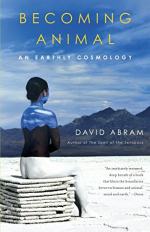|
This section contains 865 words (approx. 3 pages at 400 words per page) |

|
Becoming Animal Summary & Study Guide Description
Becoming Animal Summary & Study Guide includes comprehensive information and analysis to help you understand the book. This study guide contains the following sections:
This detailed literature summary also contains Topics for Discussion on Becoming Animal by David Abram.
The following version of this book was used to create the guide: Abram, David. Becoming Animal: An Earthly Cosmology. Vintage Books, 2010.
In Becoming Animal: An Earthly Cosmology, David Abram, an author, ecologist, philosopher, and phenomenologist, considers the possibilities of reconnecting human bodies with other animal bodies and spirits.
In the introduction, "Between the Body and the Breathing Earth," Abram introduces the ideas he will discuss in the pages to come. He does not see the book as a comprehensive statement. Rather, he hopes his writings will inspire the discovery of a new language, and mode of expression. He invites his reader to join him on his meandering explorations through the tactile world, and into experimental thought.
In "Shadow (Depth Ecology I)," the author leads the reader on an imaginary hike through the forest. The trek eventually leads into the shadow of a mountain. Abram believes that shadows are multi-dimensional. Interacting with, or entering another being's shadow, is like participating in their consciousness and life. Indeed, each being possesses and carries her own shadow, forever holding light and dark inside her.
In "House (Materiality I)," Abram writes in his dugout studio in his new house in New Mexico. Before moving here, he and his family lived in another home. This previous house was where his daughter, Hannah, was born. As an infant, she filled the space with youthful energy. When she left on a trip, Abram noticed the house's sadness. He spoke to the house, explaining where Hannah was, and the house's spirits lifted. Abram believes, like the house, that all objects and beings are animate.
In "Wood and Stone (Materiality II)," Abram considers his daughter's relationship to the world around her. Until children acquire verbal language, their awareness is expansive. They do not see other creatures as beneath them. Language imposes this hierarchy. If children were allowed to discover their world with prolonged curiosity, they might have a closer relationship with the natural world.
In "Reciprocity (Knowledge I: Science and Experience)," Abram describes his academic past. While he initially believed these scientific studies were deepening his understanding of nature and animals, he soon discovered this was not true. Having immersed himself for so long in words and theories, Abram began seeing animals and landscapes as mechanical and inanimate. He endeavored to reestablish his old connections with other living beings.
In "Depth (Depth Ecology II)," Abram hikes through the woods. As he moves, the terrain around him shifts and mutates. He realizes that his body is an integral part of the landscape, too. Being in the wild, allows the individual to understand how nature affects her, and how she affects it. The individual's perception and awareness grow and deepen through communion with the landscape.
In "Mind (Knowledge II: The Ecology of Consciousness)," Abram describes philosophers René Descartes' and Baruch de Spinoza's theories on the separation or union of mind and body. Descartes' believed they were dichotomous. Spinoza believed they were inseparable. Abram agrees with Spinoza's notions, advocating for a more full-bodied engagement with the natural world.
In "Mood (Depth Ecology III)," Abram describes a series of weather patterns and their effects on his moods and emotions. He interrogates his own responses to nature. He encourages his reader to consider not only how nature's patterns impact her, but how she impacts nature's patterns as well.
In "The Speech of Things (Language I)," Abram kayaks through Alaskan waters. Suddenly he encounters a crowd of sea lions. Then a humpback bursts repeatedly out of the water. Instead of becoming afraid, Abram communicates with the animals using song and gesture. The encounter changes his understanding of language. He now believes all species can communicate.
In "The Discourse of the Birds (Language II)," Abram watches several ducks fly against a tempestuous wind. He notes their innate intelligence. Unlike humans, birds can communicate with, and read the sensations of other elements and creatures.
In "Sleight-of-Hand (Magic I)," Abram describes his youthful travels through the Himalayas. He began seeking out local sorcerers and healers, hoping to learn from them. Eventually he began staying with a renowned healer, Sonam. Sonam taught him about the magic found in the body's communion with the land and other animals.
In "Shapeshifting (Magic II)," Abram argues that the human body allows the individual to metamorphose. He then returns to his story about Sonam. While apprenticing under Sonam, Abram learned how to study other creatures. With time, he was able to transpose his mind and senses into the physical terrain of a raven.
In "The Real in Its Wonder (Language III)," Abram wanders through the Badlands, marveling at humanity's insignificance. When he sees a metal sign, he gets distracted. Abram notices how the written word has the power to limit the boundlessness of nature. He argues that the loss of oral storytelling traditions has further distanced the modern human from the land.
In the conclusion, "At the Heart of the Heart of the World," Abram shares several myths about the sun's journey into the underworld each night. He uses these examples to suggest the importance of reconnecting with indigenous and aboriginal tales. These ancient myths illustrate former cultures' ability to embrace the mystery of the natural world.
Read more from the Study Guide
|
This section contains 865 words (approx. 3 pages at 400 words per page) |

|



